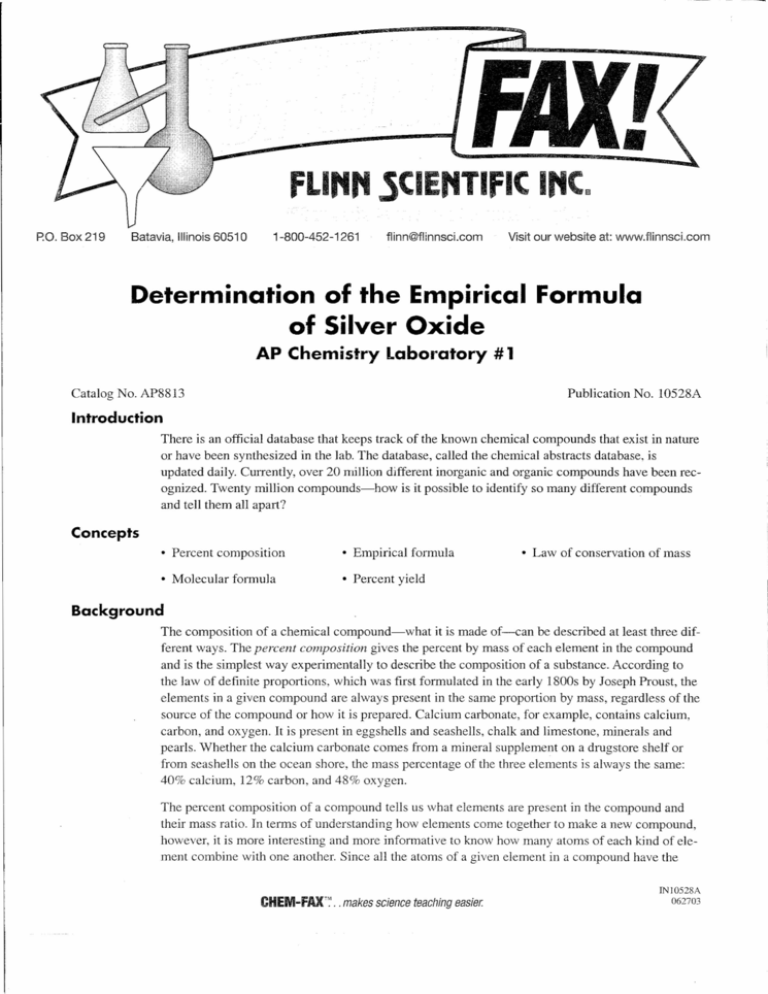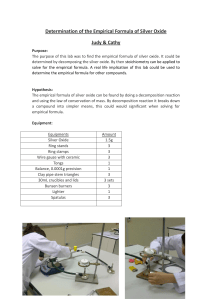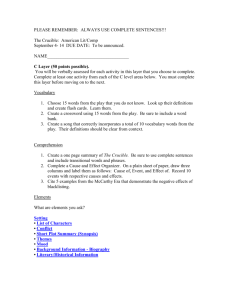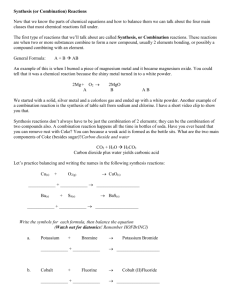
P.O. Box 219
1-800-452-1261
Batavia, Illinois 60510
flinn@flinnsci.com
Visit our website at: www.flinnsci.com
Determination of the Empirical Formula
of Silver Oxide
AP Chemistry Laboratory # 1
Catalog No. AP8813
Publication No. 10528A
Introduction
There is an official database that keeps track of the known chemical compounds that exist in nature
or have been synthesized in the lab. The database, called the chemical abstracts database, is
updated daily. Currently, over 20 million different inorganic and organic compounds have been recognized. Twenty million compounds-how
is it possible to identify so many different compounds
and tell them all apart?
Concepts
• Percent composition
• Empirical formula
• Molecular formula
• Percent yield
• Law of conservation of mass
Background
The composition of a chemical compound-what
it is made of-can be described at least three different ways. The percent composition gives the percent by mass of each element in the compound
and is the simplest way experimentally to describe the composition of a substance. According to
the law of definite proportions, which was first formulated in the early 1800s by Joseph Proust, the
elements in a given compound are always present in the same proportion by mass, regardless of the
source of the compound or how it is prepared. Calcium carbonate, for example, contains calcium,
carbon, and oxygen. It is present in eggshells and seashells, chalk and limestone, minerals and
pearls. Whether the calcium carbonate comes from a mineral suppJement on a drugstore shelf or
from seashells on the ocean shore, the mass percentage of the three elements is always the same:
40% calcium, 12% carbon, and 48% oxygen.
The percent composition of a compound tells us what elements are present in the compound and
their mass ratio. In terms of understanding how elements come together to make a new compound,
however, it is more interesting and more informative to know how many atoms of each kind of element combine with one another. Since all the atoms of a given element in a compound have the
CHEM-FAXT~ .. makes science teaching easier.
INI0528A
062703
Determination
of the Empirical Formula of Silver Oxide
Page 2
same average atomic mass, the elements that are present in a fixed mass ratio in a compound must
also be present in a fixed number ratio as well. The empirical formula describes the composition of
a compound in terms of the simplest whole-number ratio of atoms in a molecule or formula unit of
the compound. The empirical formula gives the ratio of atoms in a compound and does not necessarily represent the actual number of atoms in a molecule or formula unit. It is possible, in fact, for
different compounds to share the same empirical formula.
The organic compounds acetylene and benzene, for example, have the same empirical formula,
CH---one hydrogen atom for every carbon atom. These two compounds, however, have very different properties and different molecular formulas-c-Cjl'L and CJL; for acetylene and benzene, respectively. Notice that in both cases, the molecular formula is a simple multiple of the empirical formula.
The molecular formula of a compound tells us the actual number of atoms in a single molecule of a
compound. In order to find the molecular formula of a compound whose empirical formula is
known, the molar mass of the compound must also be determined.
Experiment Overview
In this experiment, the percent composition and empirical formula of silver oxide will be determined. Silver oxide decomposes to silver metal and oxygen when strongly heated. Heating silver
oxide causes the oxygen to be driven off, leaving only the silver metal behind. According to the
law of conservation of mass, the total mass of the products of a chemical reaction must equal the
mass of the reactants. In the case of the decomposition of silver oxide, the following equation must
be true:
Mass of silver oxide
=
Mass of silver metal + Mass of oxygen
If both the initial mass of silver oxide and the final mass of the silver metal are measured, the
decrease in mass must correspond to the mass of oxygen that combined with silver. The percent
composition and empirical formula of silver oxide can then be calculated, based on combining the
ratios of silver and oxygen in the reaction.
Pre-Lab Questions
A piece of iron weighing 85.65 g was burned in air. The mass ofthe iron oxide produced was
118.37 g.
1. Use the molar mass of iron to convert the mass of iron used to moles.
2. According to the law of conservation of mass, what is the mass of oxygen that reacted with the
iron?
3. Calculate the number of moles of oxygen in the product.
4. Use the ratio between the number of moles of iron and number of moles of oxygen to calculate
the empirical formula of iron oxide. Note: Fractions of atoms do not exist in compounds. In
the case where the ratio of atoms is a fractional number, such as \12, the ratio should be simplified by multiplying all the atoms by a constant to give whole number ratios for all the atoms
(e.g., HOI/2 should be H20).
© 2003 Flinn Scientific, Inc. AU Rights Reserved. Reproduction
permission is granted only 10 science teachers who have purchased Determination
of the Empirical
No. AP8813. from Flinn Scientific. Inc. No part of this material mny be reproduced or transmitted in any form or by any means. electronic or mechanical,
including,
recording. or any information
storage and retrieval system, without permission In writing from Flinn SCIentific, Inc.
Formula of Silver Oxide, Catalog
but not limited to photocopy,
Determination of the Empirical Formula of Silver Oxide
Page 3
Materials
Silver oxide samples, 0.5 g
Balance, milligram (0.001-g precision)
Crucible and crucible lid, 15- or 30-mL
Clay pipestem triangle
Crucible tongs
Wire gauze with ceramic center
Bunsen burner
Wash bottle and water
Ring stand and ring clamp
Watch glass (optional)
Safety Precautions
Silver oxide is slightly toxic and is a fire risk when in contact with organic material or ammonia.
Handle the crucible and its lid only with tongs. Do not touch the crucible with fingers or hands.
There is a significant bum hazard associated with handling a hot crucible-remember
that a hot
crucible looks exactly like a cold one. Always keep your face at arm's lengthfrom the crucible.
Wear chemical splash goggles and chemical-resistant gloves and apron. Wash hands thoroughly
with soap and water before leaving the laboratory.
Procedure
1. Set up a Bunsen burner on a ring stand beneath a ring clamp holding a clay
pipestem triangle. Place the crucible in the clay triangle (See Figure 1.) Do
NOT light the Bunsen burner.
2. Adjust the height of the ring clamp so that the bottom of a crucible sitting in the clay triangle is about 1 em above the burner.
This will ensure that the crucible will be in the hottest part of
the flame when the Bunsen burner is lit.
3. Light the Bunsen burner and brush the bottom of the crucible with the burner flame for about one minute. Turn
off the Bunsen burner and allow the crucible to cool.
4. Using tongs to handle the crucible, measure the
mass of a clean, empty crucible and its lid to the
nearest 0.001 g. Record the mass in the Data
Table.
5. Using proper transfer techniques, add approximately 0.5 grams of silver oxide sample to the
crucible. Measure the combined mass of the crucible, crucible lid, and silver oxide to the nearest
0.001 g. Record the mass in the Data Table.
6. Place the crucible with its lid on the clay triangle
as shown in Figure 2. Light the Bunsen burner
again and slowly heat the crucible by brushing
the bottom of the crucible with the Bunsen burner
flame for 2-3 minutes.
Figure 1.
Ring,
Support
Stand,
Support
~
Triangle,
Pipe Stem
(!)
j
LabomtN(Q
Burner
Heat gently to
avoid spattering.
\ \
Figure 2.
7. Place the burner on the ring stand and gently heat the crucible for an additional 10 minutes.
© 2003 Flinn Scientific, Inc. All Rights Reserved. Reproduction permission is granted only to science teachers who have purchased Determination of the Empirical Formula of Silver Oxide. Catalog
No. AP8813, from Flinn Scientific, Inc. No part of this material may be reproduced or transmitted in any form or by any means, electronic or mechanical, including. but not limited to photocopy,
recording, or any information storage and retrieval system, without permission in writing from Flinn Scientific, Inc.
Determination of the Empirical Formula of Silver Oxide
Page 4
8. After 10 minutes, adjust the burner to maximize the flame
temperature. Heat the crucible with the most intense part of
this flame for 10 minutes. Caution: Do not inhale the
smoke! Do not lean over the crucible. Keep the crucible at arm's length at all times.
9. After 10 minutes, turn off the gas source and
remove the burner.
10. Using tongs, remove the crucible lid and
place it on a wire gauze on the bench top.
With the tongs, remove the crucible from
the clay triangle and place it on the wire gauze as
well. (See Figure 3.)
Figure 3.
11. Allow the crucible and its contents to cool completely on the bench top for at least 10 minutes.
12. Measure the combined mass of the crucible, crucible lid, and silver metal product. Record the
mass in the Data Table.
13. (Optional) If time permits, dump the contents of the crucible onto a watch glass. Note the
appearance and consistency of the product. Is any unreacted silver oxide still present? Record
all observations in the data table.
14. Dump the entire contents of the crucible into the waste container provided by the instructor.
Carefully clean the crucible and crucible lid.
15. Repeat steps 4 to 14 for trials #2 and #3.
Data Table
Mass of crucible and lid, g
Mass of crucible, lid, and silver oxide, g
Mass of crucible, lid, and silver metal, g
Appearance of product
© 2003 Flinn Scientific, Inc. All Rights Reserved. Reproduction permission is granted only to science teachers who have purchased Determination of the Empirical Formula of Silver Oxide, Catalog
No. AP8SJ 3, from Flinn Scientific, Inc. No part of this material may be reproduced or transmitted in any form or by any means, electronic or mechanical, including, but not limited to photocopy,
recording, or any information storage and retrieval system, without permission in writing from Flinn Scientific, Inc.
'
Determination of the Empirical Formula of Silver Oxide
PageS
Post-Lab Calculation and Questions
(Use a separate sheet a/paper to answer the/allowing
questions. Show all your calculations.)
Create a Data Results Table for each trial with the following categories: the mass of silver oxide in
grams, the mass of silver metal produced in grams, the mass of oxygen gas produced in grams, the
percent composition of silver, the percent composition of oxygen, the moles of oxygen in the silver
oxide sample, the moles of silver in the silver oxide sample, the mole ratio of AgiO in silver oxide,
and finally, the empirical formula of Ag.O;
1. Calculate the mass of silver oxide and the mass of the silver metal product. Use the law of conservation of mass to calculate the mass of oxygen that combined with the silver. Enter the
answers in your Data Results Table.
2. What is the percent composition of silver and oxygen in silver oxide? Enter the answers in
your Data Results Table.
3. Use the molar masses of silver and oxygen to calculate the number of moles of each product.
Enter the answers in your Data Results Table.
4. Calculate the ratio between the number of moles of silver and the number of moles of oxygen
in the product. What is the empirical formula of silver oxide? Enter the answers in the Data
Results Table.
S. Write a balanced chemical equation for the decomposition of silver oxide to form silver metal
and oxygen.
6. The theoretical yield of a product in a chemical reaction is the maximum mass of product that
can be obtained, assuming 100% conversion of the reactant(s). Calculate the theoretical yield
of silver metal in this experiment. Hint: Calculate the molar mass of silver oxide.
7. The percent yield reflects the actual amount of product formed versus the maximum that might
have been obtained. Use the following equation to calculate the percent yield of silver metal
produced in this experiment.
% yield
actual mass of product (g)
theoretical mass (g)
X
100%
8. Discuss sources of error in this experiment that might account for a percent yield lower or
higher than 100%. Be specific!
© 2003 Flinn Scientific, Inc. All Rights Reserved. Reproduction
permission is granted only to science teachers who have purchased
Determination
of the Empirical Formula of Silver Oxide, Catalog
No. APS8] 3, from Flinn Scientific, inc. No part of this material may be reproduced
or transmitted
in any form or by any means, electronic or mechanical,
including. but not limited to photocopy.
recording. or ~U1y information
storage and retrieval system, without permission
in writing from Flinn Scientific, Inc.








